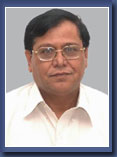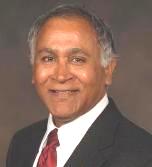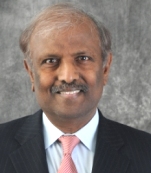Address for correspondence
The Secretariat, ACODS-2012
C/O Prof. R. Padhi (General Chair)
Department of Aerospace Engineering,
Indian Institute of
Science,
Bangalore 560 012, India.
Phone: +91-80-22933036, 22932503
Fax: +91-80-23601279,23600134
E-mail: [email protected]
|
Plenary Speakers
Plenary Lectures:
Dr. V. K. Saraswat
Director General of Defense R&D Organisation, India
and Scientific Advisor to Defense Minister, Govt. of India
Title: Interception of high speed airborne threats: challenge to guidance & control
Read more || Hide
Abstract :
High speed airborne threats are basically categorised as two classes : (a) Maneuvering / Non maneuvering Ballistic Missile (BM) and (b) Quasi ballistic missile. Non maneuvering BM can be intercepted at high altitude with already matured subsystem like IIR seeker, Divert & Attitude Control system. However interception becomes difficult if (i) Reentry payload deploys countermeasure and (ii) Reentry vehicle deploys MIRVs ( Multiple Independently
Targeted Reentry Vehicle. While the first problem can be tackled by designing homing sensors with discrimination capability with relatively small change in design of Kill Vehicle, second problem can be solved by designing multiple kill vehicles (MKV). Both these options have not matured yet and significant effort is required to realize hardware such as discrimating sensors, MKV. Interception of TBM( maneuvering / non maneuvering) at endo atmosphere requires accurate estimation of target states and fast autopilot with high maneuverability of interceptor as fast target will have large maneuvering potential at endo
atmosphere. In this paper, few examples are given in terms of generalized
maneuvering taget state estimation and fast autopilot for an endo-atmospheric interceptor. Homing sensors for low endo atmospheric interception is generally of RF type from point of view of all weather operation. Problem of Discrimination of target at lower atmosphere does not exist as decoys are naturally dscriminated after reentry. Problem of intercepting TBM at high endoatmosphere/ low exoatmosphere poses another challenge in terms of reduced lateral aerodynamic acceleration capability of interceptor. Hence fast autopilot design is a challenge which can be tackled by designing kill vehicle with multiple control effectors. Moreover long range interceptors of such class also require special midcourse guidance in terms of minimum energy and suitable intercept angle. Discrminating sensors are required if kill altitude is above 50 Km otherwise RF sensors are
sufficient. Quasiballistic Missiles are characterized by high speed and slow maneuver ( although with a high maneuvering potential) at relatively high
altitude ( < 50 Km) to cover extra range. Interception of such missiles are possible with quick reaction interceptors having
accelerating kill vehicle with RF sensors with larger field of regard. Estimation of maneuvering target states is also a challenge which can be solved by earlier mentioned generalized state estimator. Challenge of guidance, control, estimation and system engineering aspects for these problems will be addressed in this paper.
 Biography: Biography: Dr Vijay Kumar Saraswat, has been appointed SA to RM, DG DRDO, Secretary Defence R&D w.e.f. 1st Sep 2009. He started his career in DRDO in 1972 with development of India's first Liquid Propulsion Engine, DEVIL. An MTech from Indian Institute of Science (IISc) Bangalore, he obtained a Doctorate in Propulsion Engineering from Osmania University. He established facilities for design, production and testing of engines and the RCS technologies for the missile applications.
Dr Saraswat is fellow of National Academy of Engineering, Aeronautical Society of India, Astronautical Society of India, and Institution of Engineers. He is a member of governing council of SAMEER and member of Board of Research of AICTE, CSIR labs, and board of studies of Osmania University. He is Chairman, Combustion Institute (Indian Section), and Aeronautical Society of India (Hyderabad Branch).
Dr Saraswat is the recipient of DRDO Scientist of the Year Award - 1987, National Aeronautical Prize - 1993, DRDO Technology Transfer Award - 1996 and Performance Excellence Award - 1999. For his outstanding contributions to the Nation, he has been conferred with Padma Shri in 1998.
Dr. Ian Craig
President, International Federation of Automatic Control (IFAC)
Professor, University of Pretoria, South Africa
Title: HIV/AIDS therapy as a control engineering problem
Read more || Hide
Abstract:
Antiretroviral therapy for the treatment of human immunodeficiency virus (HIV) infection can be seen as the control of a nonlinear time varying dynamical system with constrained controls. Antiretroviral drugs act as the control signals and the controlled variables typically include the plasma HIV viral load. This presentation will be structured around the feedback control block diagram as it relates to antiretroviral therapy: the plant, measurement, controller and actuator blocks. Potential control strategies that are based on clinically motivated control objectives and performance specifications will be highlighted. Limitations imposed by available actuators and measurements will be discussed as well as the role of HIV/AIDS therapy in control engineering education.
 Biography: Biography: Ian Craig received the B.Eng. degree in electronic engineering from the University of Pretoria, South Africa, the S.M. degree from the Massachusetts Institute of Technology, Cambridge, USA, and the Ph.D and M.B.A. degrees from the University of the Witwatersrand, Johannesburg, South Africa. He is Professor and Section Head: Control Systems in the Department of Electrical, Electronic and Computer Engineering at the University of Pretoria, a position he has held since 1995. Previously he was Group Leader in the Measurement Control Division of Mintek where he was awarded for his work on the design, implementation and commercialisation of advanced controllers for the mineral processing industry.
Ian is the current President of IFAC, the International Federation of Automatic Control. He has served IFAC in many different roles, including as a Technical Board,
Executive Board and Council Member. He also served as the Editor-in-Chief of the IFAC journal Control Engineering Practice from 2005 to 2010 and received
IFAC Outstanding Service Award in 2008. Ian is an active member of the South African Engineering community. He is a Fellow of the South African Academy of
Engineering, a Fellow of the South African Institute of Electrical Engineers, Past President of the South African IFAC National Member Organization, and
founding President of the MIT Club of South Africa. His research interest include the economic performance assessment of advanced process control; HIV/Aids
modelling, identification and control; and modelling and control of systems in mineral and metal processing.
Dr. Siva Banda
Director, Control Science Center of Excellence, AFRL, USA
Fellow of AFRL, AIAA, IFAC and Royal Aeronautical Society
Title:Autonomy and Control for Aerospace Systems: Challenges in Unmanned Arial Vehicles
Read more || Hide
Abstract:There have been many advances in aerospace systems in recent years, but none more of a game changer than unmanned aerial vehicles. These vehicles have enabled a new era in battlefield persistence and surveillance. Key enablers in this capability are long haul and high bandwidth communications; advanced sensors including high resolution day/night full motion video; and increased automation of task planning and execution. The objective for these vehicles is to be operated less as remotely piloted vehicles, but operated more as vehicles that have an increasing level of autonomy. Recent advances in increasing autonomy that are in the development stage include collision avoidance, air-air refueling, automated terminal area operations, and integration into the national air space. This presentation will emphasize recent progress, using three examples, in on-line decision making under uncertainty, cooperative control of multiple vehicles, and the integration of man and machine. Persistent patrol is the first example of a scenario dominated by stochastic alerts and false alarms. The on-line controller must decide which alerts to service next (and how long to service them) to maximize the overall quality of service. The controller, by modeling the uncertainty, is not myopic and can account for expected future events. This is also shown for multiple vehicles. The road surveillance problem (second example) is motivated by the search for roadside objects. Multiple vehicles automatically distribute the workload using a decentralized approach. Moreover, the visitation frequency can be determined by including a priori information about the possible distribution of the objects. This is shown for variations of star road networks. The third example problem is the integration of an operator model into a sequential inspection scenario. Here, an operator error model is incorporated into the design of the controller to enable a reduction in false alarm rate by determining how and when to seek additional information.
Some long term research challenges in achieving autonomy are briefly discussed in the presentation. Among these is the operator functioning as detector and classifier in the control loop. Another is decentralized control where increasing numbers of vehicles are managed by a single operator. Finally, partial information is discussed, which introduces the difficulties of simultaneous estimation and control. The presentation concludes with a brief commentary on problems associated with false information (deception) and adversary actions (games).
 Biography: Biography: Dr. Siva S. Banda is the Chief Scientist of Air Vehicles Directorate, Air Force Research Laboratory (AFRL), Wright-Patterson Air Force Base, Ohio, USA. Dr. Banda has dedicated his career to ensuring that the aerospace industry possesses the cutting-edge flight control solutions essential to fielding revolutionary air and space platforms for both military and commercial applications. He has been a part of AFRLs scientific professional research staff since 1981.
Dr. Bandas personal professional contributions have been recognized in multiple forums and in multiple ways, most notably through: IEEE Control Systems Technology Award; the Royal Aeronautical Society (RAeS) Silver Medal; IFAC Nathaniel Nichols Medal, the Meritorious Presidential Rank Award; the Distinguished Presidential Rank Award; election as a Fellow of RAeS, AIAA, IEEE, and IFAC; and Membership of the National Academy of Engineering. He serves on Advisory Boards at the University of Southern California, the University of Central Florida, University of Michigan, and SIAM. He serves as an Advisor to AFOSR, ONR, ARO, DARPA, NSF, and leads several international technical activities within the NATO Research and Technology Organization. He has served on the Editorial Boards of the IEEE Transactions on Control Systems Technology, the International Journal of Robust & Nonlinear Control, and the AIAA Journal of Guidance, Control & Dynamics. He also has served as thesis adviser and adjunct professor at the Air Force Institute of Technology, Wright State University, and University of Dayton.
Dr. Banda received his B.E. in Electrical Engineering from the Regional Engineering College, Warangal, India; his M.E. in Aeronautical Engineering from the Indian Institute of Science, Bangalore; an M.S. in Systems Engineering from Wright State University; and a PhD in Aerospace Engineering from the University of Dayton in 1974, 1976, 1978 and 1980 respectively. He has authored over 200 technical papers, reports and books, holds two patents, and has delivered more than 120 invited lectures worldwide.
Dr. S. N. Balakrishnan
Professor, Missouri University of Science and Technology - Rolla, USA
Title:Approximate dynamic programming based solutions to Optimal Control Problems using Neural Networks
Read more || Hide
Abstract:Many feedback controllers have been synthesized with neural networks. This talk will focus on obtaining solutions to nonlinear, stochastic, and distributed optimal control problems using neural networks. These solutions are based on a formulation called the adaptive critics. Various adaptive critics in the literature will be presented and the single network adaptive critics developed by the speakers group will be discussed in detail. Solutions to finite-time and infinite time and constrained control problems will form a part of this talk. Results from tracking, regulation, heat transfer, missile guidance, inventory control etc. will be shown. Implementation results from vibration and heat transfer applications will also be presented. Extensions to handling model uncertainties with an online neural network will also be discussed.
 Biography: Biography: Dr. S. N. Balakrishnan received his Ph.D. from University of Texas at Austin, USA. He is with Missouri University of Science and Technology, Rolla, USA since 1985 and is currently a curators professor in the Department of Mechanical and Aerospace Engineering. He is an Associate Fellow of the American Institute of Aeronautics and Astronautics (AIAA).
Dr. Balakrishnans major technical contributions include the development of a new closed form suboptimal control for nonlinear systems called the Theta-D control which approximates solutions to the Hamilton-Jacobi-Bellman equations. He has a strong research record in intelligent control and was the first to develop optimal neurocontrollers for systems modeled by partial differential equations and for systems driven by impulse inputs. He has developed optimal control and filters solutions to spacecraft, helicopter, missile, aircraft, manufacturing, and MEMs problems using neural networks. He has also developed and implemented optimal temperature profile control, vibration control and aircraft control using neural networks. Dr. Balakrishnan has also advanced a new approach to guidance and control called the Integrated Guidance and Control (IGC) and has shown its success in missile interception problems. Dr. Balakrishnans research has been supported by the National Science Foundation for about 20 years, US Army Space and Missile Defense Command, Naval Surface Warfare Center, US Air Force, the Missile Defense Agency, NASA Langley, NASA Goddard, NASA Ames, and NASA Marshall, and some industries. Currently, Dr. Balakrishnan is investigating principles from cognitive sciences in decision making with some collaborators which he believes is a prerequisite and the key to the design of intelligent systems.
Dr. L. Mestha
Principal Scientist and Project Leader, Xerox Research Center, USA
Title:Control of Color Imaging Systems
Read more || Hide
Abstract :
The digital printing process is remarkably challenging because it involves many process and digital actuators for applying a range
of advanced control techniques. Many new challenges opened the door for us to inject new control theory. Although MIMO & modern
controls appears difficult to understand and implement in an industrial setting, the desire to achieve high product performance
at lower cost drove the need for the use of advanced controls. We found some technology problems are just not possible to solve
without the use of control theory. In this talk, we highlight those challenges including organizational barriers and describe
how modern MIMO control theory was used to create successful production systems. We describe the mathematical formulation of the
process, use of specialized algorithms (e.g, MIMO, model predictive control, multi objective, cooperative control theory), methods,
and architectures. Today, numerous Xerox printing systems produce high quality prints using these control innovations to generate several billion dollars revenue.
 Biography: Biography: Lalit K. Mestha, a Principal
Scientist at Xerox received his PhD from the University of Bath, England in 1985 and his BE in 1982, from the University of Mysore,
India, all in EE. He has led variety of research projects since 1987 on sensing and control of small to large scale imaging and
engineering systems. Numerous controls, imaging and sensing technologies researched by LK are being deployed in systems (particle
accelerators in Fermilab, KEK, CERN) and in imaging products (iGen3, iGen4, iGen4 220, Xerox Color 800/1000, DocuColor 5000,
DocuColor 7002/8002, DocuColor 8000 developed and marketed by Xerox), generating revenue in excess of 3.0 billion $. An inline
low cost spectrophotometer sensor researched by Mestha is manufactured by The Appcon Group, Inc., Rochester, NY. He is very active
in increasing the knowledge of system science in imaging and systems community as an outreach to advance and apply controls to the
corporate and university environment. He does this through (1) publications; 240+, which includes 196 patent filings of which 114
patents have been awarded (with 82 pending), (2) initiating and working on collaborative projects with universities, (3) serving
in National and Societal activities (NSF, IEEE CSS, ASME, IS&T), and (3) teaching over 24+ graduate courses as professor since
1990 at the UT Arlington and the Rochester Institute of Technology. He is a recipient of 2010 Anne Mulcahy Inventor Award for
contributions to color accuracy in Xerox production printing devices and 2006 IEEE Control System Technology Award. Recently
published a book Control of color imaging systems, ISBN: 978-0-8493-3746-8, by CRC Press and wrote a book chapter in The
Control Handbook, Second Edition (three volume set); ISBN 978-1-4200-7366-9. Prior to joining Xerox, Mestha was at the SSC
Laboratory in Dallas. He is a Fellow of IEEE, Certified Black Belt and teaches at RIT as an Adjunct Professor in his spare
time.
|
Semi-plenary Speakers
Fernando DAmato
GE Global Research
Title:Industrial application of optimization-based control technologies
Read more || Hide
Abstract: Recent advances in optimization, control algorithms and computing hardware have recently enabled the development of advanced control solutions for industrial operating problems. For example, the need to save fuel consumption on railroad daily operations motivated the development of online solutions on board of locomotives to calculate optimal acceleration for each train trip. In power generation applications, increasing cyclic operation of large power plants lead to the development of predictive control applications to optimize the startup process of combined cycle plants. This talk will focus on the key technology enablers for these industrial applications, a description of the industrial
implementations, the operating and economic impact of the new solutions as well as working progress for future applications.
Biography: Fernando DAmato earned the Aeronautical Engineer degree from La Plata University (Argentina), and M.S. and PhD degrees in Aeronautics
and Astronautics from Purdue University. Early in his career Fernando worked for the Argentine Space Agency developing mechanical tests, and virtual sensing
techniques for satellites. He joined GE Global Research in 2002 and has worked as a Control System Engineer in a variety of applications, including startup of
power plants, combustion in gas turbines, water desalination with wind energy, cloth drying machines and aircraft engines. He has over 20 publications and filed 7
patents. Fernando developed the first GE power plant controller with nonlinear model predictive control technology. He is currently leading a multidisciplinary
program across Global Research and Energy to develop real time optimization and modeling algorithms,
a software architecture for predictive controls and applications to combined cycle power plant operations.
Praveen Mysore
Sr Technical Manager, Dassault Systemes India
Title:Functional 3D Mock Up Simulation & Validation.
Read more || Hide
Abstract: In today’s world System design and simulation is done separately and detail engineering is done separately. And one would hardly get a chance to experience the behaviour of the Product before the physical prototype is made. And the testing done on Physical Prototypes is very much required to validate the System design which was defined during the early phase of project. And with Physcial tests it is very difficult to iterate with multiple options as it would call for cost implication. Trend is evolving to design and simulate the behaviour of multi-disciplinary systems comprising mechanical, hydraulics, controls, electrical etc., in 3D in the virtual environment and validate the same. Here one gets to iterate among multiple options and convince oneself with best option possible meaning optimizing the system for the given requirement considering performance and cost aspects. This is what is called the Functional 3D Mock Up Simulation & Validation.
Biography: Praveen Mysore is Sr. Technical Manager, Dassault Systemes India . He joined Dassault Systemes in 2001 as CATIA V5 Solutions Specialist. Before joining Dassault Systemes, he has worked for one of the Big Automotive OEMs, Mahindra & Mahindra, the Manufacturers of SUVs and MUVs, as Press Tool Engineer for two years.
With Dassault Systemes, he has worked with many Automotive and Aerospace OEMs in India and ASEAN region in deployment of DS solutions. He has worked with Tata Motors, India, NAL, ADA, Hero Honda, Hindustan Aeronautics Limited, where DS Solution is being used for quite sometime now.
Praveen holds Master degree in Tool Design and BachelorDegree in Mechanical Engineering
|
|

